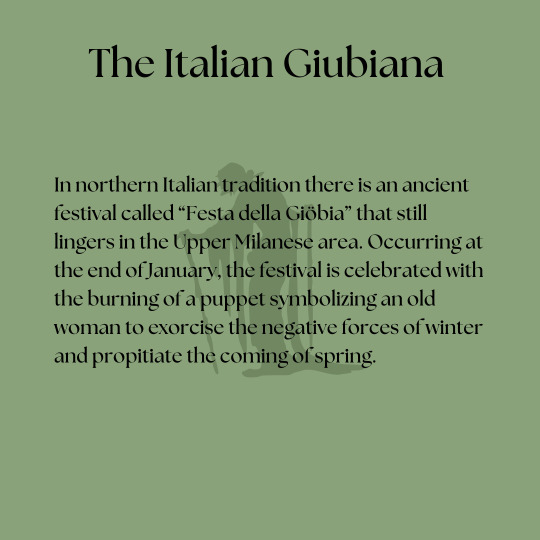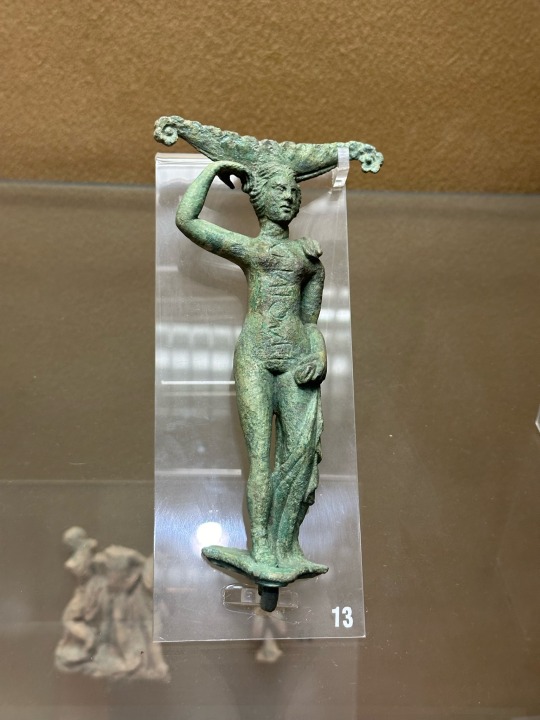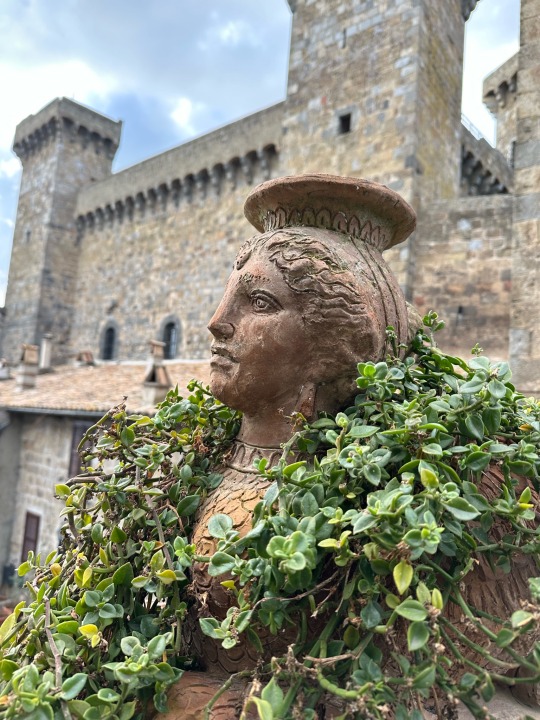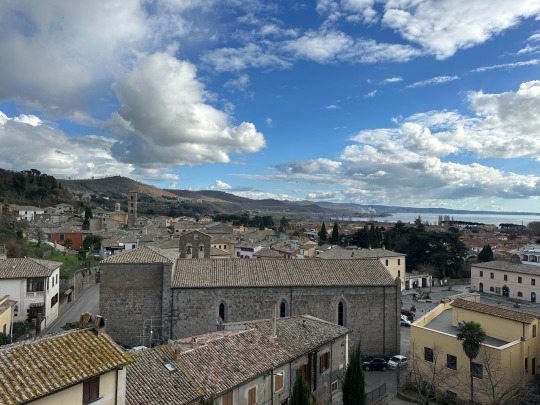#WITCHCRAFT IN ITALY
Text
ANOTHER NOT REQUIRED STORY TIME BECAUSE WHY NOT?
SO, yk, I live in Italy. Especially in the small towns of southern Italy they take the "don't let anyone touch your hair" too seriously, especially if the aforementioned hair belongs to a young woman or, even worse, a little girl. As a result, you have to look after your hair from the moment you are born until you get married and have healthy children. To tell you, my maternal grandmother kept repeating to me over and over again "don't let anyone touch your hair other than me, your mother or your other grandmother. Especially if it is some other woman who is complimenting you. If it happens, wash them as soon as you get home AND PRAY." CONSEQUENTLY, I grew up terrified and always wore my hair tied up. In particular, my grandmother wanted me to wear them braided, when she could she tied them, but in any case this led me to know how to do braids from a very young age. However, I remember that my grandmother used to use my hair as if it were a Catholic rosary, so while braiding it she prayed, so it took about an hour to make two braids.
ANYWAY, I've always worn very long hair as a child until one day, a sister-in-law of my grandmother literally forced me to tie my hair from her. Bad things started to happen to me (for example since then I suffer a lot from sore throat) and my grandmother proposed to cut my hair. Yes, you read that right, they cut them off. The bad things stopped happening (I was just left with these very fragile tonsils that get sick with nothing). From that day on every time, for example, I argue with someone, cut relationships, etc., I cut my hair. As a child I forced my mother to take me to the hairdresser and I literally made extreme and unnecessary cuts (I also have a trusted hairdresser and I absolutely refuse to go to someone else), now that I am more aware of my spirituality I cut them myself and I only cut the ends.
ANYWAY pt2, Before, I was braiding my hair and was in the bathroom. My bathroom's balcony overlooks the point where the sun sets and therefore around this time it is always illuminated by this beautiful warm light. I have this subconscious reflex of thanking or praying to Lord Apollo whenever I see a beautiful sunset (usually I never see the sunrise but when I do I pray during it too) so, involuntarily I started praying to the rhythm of how I braided my hair and it reminded me of when I was little and my grandmother used my hair as a rosary. Luckily it didn't take me hours to finish tying my hair but I felt a sense of warmth in my heart, I don't know.
I think now I will start praying while I tie my hair also because sometimes I have such full days that I can't even make a very short prayer, if I started praying before going to sleep while I tie my hair, it would become an autonomous gesture and I would be sure to be able to address at least one daily thought to my gods and I would feel much better.
#MIC TALK#WITCHCRAFT IN ITALY#apollo devotee#apollo worship#witch blog#witchcraft#italian witch#italian witchcraft#witch tips
9 notes
·
View notes
Text
Salvadis


The Salvadis in Friulian Folklore: Guardians of Storms
In the rich tapestry of Friulian mythology, the Salvadis (Planetnik in Slavic folklore) stand out as enigmatic figures with a formidable connection to natural phenomena. Originating from Slavic countries along with Friuli region in northeastern Italy, these mythical beings are intimately associated with storms and hail, embodying both the awe and fear inspired by unpredictable weather.


Nature and Appearance
Salvadis are often depicted in various forms, such as horses, cows, goats, or pigs in the sky. This transformation into animal shapes is seen as a forewarning of severe weather. When these entities take on a human guise, they are believed to spread their arms and legs to release hailstones, causing damage to crops and property. This human form is a direct manifestation of their power to influence the weather, marking their role as harbingers of stormy conditions.

Role in Weather Phenomena
The primary role of the Salvadis is to generate storms and hail. In Friulian folklore, their appearance in the sky is a significant omen, signaling the approach of adverse weather. The connection between the Salvadis and weather patterns underscores a cultural effort to understand and manage the unpredictable forces of nature. This mythological explanation provided a framework for coping with the challenges posed by severe weather.


photo: bad weather in Faedis with unusual snow in late April
Protective Rituals
The 1948 testimony from Canal di Grivò in Faedis offers a glimpse into how these beliefs were practiced in the mid-20th century.
To safeguard their lands from the Salvadis, local inhabitants engaged in various protective rituals. One common practice involved marking or consecrating the boundaries of their property. This ritual was believed to prevent the Salvadis from crossing into their territory and unleashing their destructive power. Such practices highlight the community's proactive approach to mitigating the impact of natural disasters through cultural and ritualistic means.
🌬️🌬️🌬️🌬️🌬️🌬️🌬️🌬️🌬️🌬️🌬️🌬️🌬️🌬️🌬️🌬️🌬️🌬️
[first 5 photos are from Pinterest, last two are mine]
#folklore legends#folklore#spirituality#cottage aesthetic#cottagecore#cozy cottage#forest spirit#italian alps#italy#story#history#culturalheritage#italia#alps#myths and legends#celtic mythology#slavic#salvic mythology#pagan#paganblr#pagan witch#forest spirits#animism#shintoism#christianity#folk christianity#folk witchcraft#interesting facts#fiabe#friuli venezia giulia
86 notes
·
View notes
Text

sunrise with theo 🌅
I can just imagine going to his family's house in Italy for the summer and dragging him out of bed at half 4 to see the sunrise, enjoyyy x
Our bodies tangled together, our legs crossing eachothers as my head is buried into Theo's chest. A faint buzz causes me to stir, my eyes fluttering open only to be greeted by a dishevelled, sleeping boy infront of me. His hair fell messily into his closed eyes, his breathing slow and soft; it reminds me of a cat purring. Peaceful. The buzzing grew louder, I turn my head in the direction of the noise. My phone is flashing and buzzing on his nightstand; 4:25 am. Wriggling out of his grasp, I have to steady my hands on his bare chest sitting up and turning off my alarm. A low, muffled groan comes from beside me, Theo. His hands rub the bed where I previously lay before his hand finds my thigh rubbing slow circles with his thumb moving his head to rest on my lap. My hands move to his hair massaging his head slightly emiting another soft sight from him.
"g'morning" I whisper to him trailing a hand down his face rubbing his jaw and cheek.
"what time is it bella?" His voice is a deep rumble against my thighs, I smile down at him.
"half 4" Theo is not a morning person so I didn't expect him to be too happy about his abrupt awakening so early.
"why amore?" he huffs moving his hands to kneed my thighs.
"i wanna watch the sunrise with you at the beach, love" from the Nott's summerhouse the beach is barely a 4 minute walk, it's where me and Theo have mostly been for the past 2 weeks.
"please ragazzo" Theo practically caves when I speak Italian to him, he finds something so endearing about hearing me speak his native tongue. There was a slight pause, I knew he was thinking about it. I was his girl, he'd do anything if it made me happy.
"fine" he huffs "when does it rise?" I practically squeal with excitement leaning down to kiss his cheek.
"5, sunrise is at 5 and theres a really cute cafe we can get a coffee from i saw it yesterday when we went to the beach" I smile down happily at him, I see a smile tug at his lips, he sits up with a stretch, his boxers hung low on his hips, and with a slight groan he tiredly stands up, offering me a hand.
"shall we?" a soft smirk plays at his lips, such a gentleman. My gentleman.
#hp fanfic#slytherin#summer#italy#lorenzo zurzolo#theo x reader#theodore nott#x yn#hp#slytherin boys#so hot and sexy#sunrise#coffee#holiday#hogwarts school of witchcraft and wizardry
41 notes
·
View notes
Text
I believe in Italian Theodore nott like this man can and will speak fluent Italian to you just to confuse your brain before kissing you …
#theodore nott#theo nott#x yn#theo nott x you#theo nott x y/n#hogwarts houses#hogwarts school of witchcraft and wizardry#italy#italian#slytherin#slytherin boys
155 notes
·
View notes
Text
Malocchio: Calabria and the old superstitious belief of the evil eye

Generally, in Calabria and Southern Italy, especially in the past, people tended to be afraid of causing jealousy and envy so understate all success.
According to a widespread belief, envy is at the base of malocchio, the evil eye, from the combination of mal, bad, and occhio, eye. The evil eye is a form of curse, transmitted through the gaze, hence the name, many cultures believe causes injury or bad luck to the person it is directed.
The dictionary definition is “malevolent power, attributed by superstition to the gaze of certain people”. There are two different types of this phenomenon: malocchio and affascino, fascination, which means fascinated through malocchio. Both derive from envy, the first has an evil intent and the second may also derive from innocent admiration of another person’s virtues or fortunes; both will cause discomfort and illness.
Older people even today advise to stay alert when one receives too many compliments and to use amulets or prayers as countermeasures: horns, horse shoes, the little hunchback, garlic, hot chili pepper, or throwing salt behind one’s back.
Usually an old lady, who has received this wisdom by the fire during Christmas night, would take a dish with water and would drop three drops of oil. If the oil almost fragments and mixes with water, the person was a victim of malocchio, if instead the oil widens over the dish there is no curse. In the first case, a ritual accompanied by prayers is carried out to free the victim. The ritual would include the use of milk or herbs like rue which apparently has amazing properties. The ritual ended with a prayer and the marking of the “victim” with a cross traced seven times with an oiled finger, which shows the commingling of religion and superstition.
Follow us on Instagram, @calabria_mediterranea
#evil eye#malocchio#superstition#superstitious beliefs#calabria#italy#italia#south italy#southern italy#mediterranean#italian#witchcraft#europe#envy#jealousy#fascination#affascino#magic#christmas night
60 notes
·
View notes
Text








Fall, but you live in rural Italy
[photos from Pinterest]
#cottage vibes#cottage living#winter cottage#cottage core#cottagecore#cottage aesthetic#cozy cottage#cozycore#cozy aesthetic#rural#rural italy#mountains#fall aesthetic#fall moodboard#autumn witch#autumn moodboard#autumn nature#autumn#witches#witchcraft#witchblr#witchcore#wiccamagic#woods#paganblr#paganism#pagan witch#alps#spirituality#photography
13 notes
·
View notes
Text

According to the folktale, the Giubiana was an old witch, thin, with very long legs and red stockings. She lived in the woods and because of her long legs, she never set foot on the ground, but moved from tree to tree. On the last Thursday of January, she used to go in search of some children to eat. One mother, to protect her child, decided to set a trap for her. She prepared a large pot full of yellow (saffron) risotto with luganega (sausage) and put it on the windowsill. The Giubiana attracted by the smell, came out of the woods, and began to eat all the contents of the huge pot. The risotto was so good that the ravenous Giubiana did not notice the time passing. She did not notice that the sun, which kills witches, was now about to rise. By the time the Giubiana finished all the risotto, the first ray of sunshine had come out: the Giubiana was thus pulverized by the sunlight, and from that day all the children were saved. To remember that event at the end of January, risotto with luganega is prepared and the puppet in the guise of the old witch is burned.
The name "Giubiana" seems related to the Roman god Jupiter, but other possible reference figures are Juno, Janus, and Diana.
In the medieval centuries the popular narrative created a variety of legends and numerous folk tales, in which Giubiana thus became a female figure alluding to the Great Mother, sometimes an old woman, sometimes a witch, a variant of the Befana, to be symbolically driven away along with the rigors of winter. The most distinguishing element of the festival is the great bonfire, which even today is perceived by all as a symbol of renewal and a new year's restart.
#witchcraft#witchblr#italianwitch#italian folklore#strega#giubiana#italian traditions#paganism#witches of tumblr#winter spirit#italian witchcraft#pagan witch#great godess#old witch#bonfire#renewal#italian tales#northern italy
37 notes
·
View notes
Text




The Festival of the snake catchers or snake-charmers) (Festa dei Serpari di Cocullo) is an annual festival held on May 1 in Cocullo, Italy in honour of St. Dominic di Sora, patron saint protecting against snakebite and toothache.
Its origins date back to paganism and have roots in an ancient celebration in honour of the Italian goddess Angitia (goddess of snake-charmers). The festival involves a procession carrying the statue of St. Dominic, draped with live snakes, through the streets of the village.
#roman polytheism#italic polytheism#italian polytheism#cultus deorum#cultus deorum romanorum#etruscan#goddess#pagan#paganism#italian paganism#stregheria#stregoneria#witchcraft#witch aesthetic#pagan aesthetic#hellenic#hellenic pagan#hellenism#rompol#helpol#greek mythology#roman mythology#norse mythology#celtic mythology#celtic polytheism#celtic paganism#italy aesthetic#culture#antiquities
7 notes
·
View notes
Text
kickstarter
"Before starting my artistic career, I spent years studying Japanese culture and traditions. Living in Japan opened my eyes to a daily spirituality that was completely foreign to me, born and raised an atheist. It enriched my life so much that, coming back to Europe, I felt empty, as I had lost an important connection to the land I walked on.
It didn’t take long for me to start researching my roots, uncovering long-lost stories, myths, and pagan traditions. Italy is a very diverse country, a collage of peculiar identities, regions, languages and people.
My goal is to depict the beauty of these traditions so that their richness will hopefully inspire others to find their own path to the old knowledge, from a time when we were closer to nature and spirits, when life was harsher, but we found strength in one another by dancing around bonfires and singing to the full moon, celebrating together the magic of every season."
Lisa, an amazing friend of mine started this Kickstarter, she is producing an italian-folklore and pagan related calendar!! Her work is amazing, take a glimpse of what she can offer!
The calendar is also full of witchcraft culture, you will have a full moon phases list and pagan festivities!
#italian#folklore#calendar#art#artist on tumblr#illustration#drawing#italy#artwork#artists on tumblr#pagan#paganism#witchcraft#pagans of tumblr#eclectic pagan#moon#moon phases#full moon
70 notes
·
View notes
Text







Bolsena today 🩶 lots of Roman/etruscan remains and art but,especially, cats 🐈



The view is better in real life though.
#personal#southern italy#italy#Roman#etruscan#Tuscia#italian witchcraft#pagan#stregheria#witch#witchblr#art history#history#archaeology
15 notes
·
View notes
Text

other social: 📷 • 🐦 • 🖼
2nd blog: @ph4oswrites
under this post you can find my hashtags!
! this account is a safe place for anyone who decides to interact with it, always provided that my and others' opinions are treated with respect !
-I'm always looking for new mutuals; feel free to interact w me via the question box and messages 🩶
12 notes
·
View notes
Text
Krivapete
In the heart of the Valli del Natisone, a region nestled in northeastern Italy, there lie tales of legendary creatures that weave together magic and ancient wisdom: the Krivapete. These mysterious beings are deeply embedded in local folklore, depicted as ancient, wise women with bird-like talons or feet, symbolizing their primordial connection to nature and the earth.


The Krivapete are often described with weathered, wrinkled skin and eyes deep as dark wells, capable of piercing through the very soul. Their talons, replacing what would be normal toes, mark their profound bond with the wild. They are said to reside in remote, almost inaccessible places: hidden caves among ancient rocks or beneath imposing boulders that tower over the landscape.


The Krivapete are credited with possessing profound knowledge of nature, herbs, and ancient remedies. They are reputed to have taught the local people essential skills, such as preparing traditional dishes like brovada (fermented turnips) and crafting cheese, butter, and even bread. However, their wisdom is not freely given; they share their secrets selectively, often requiring respect or promises in return.


One of the most famous tales tells of a man who captured a sleeping Krivapeta under a chestnut tree to learn her secrets. She agreed to teach him many valuable skills, including various food preparations, but after her release, she escaped while shouting that she had withheld the secret of making sugar, ensuring her knowledge remained incomplete. This story highlights the dual nature of the Krivapete: they are both benevolent and mischievous, guiding yet retaining some mysteries.


In other versions of the folklore, the Krivapete interact with humans to assist in seasonal agricultural tasks or rituals. For instance, in autumn, they are said to prepare radicchio soup in the village of Tribil. The Krivapete are woven into the cultural fabric of the Valli del Natisone, blending mythology with practical knowledge of local customs and culinary traditions.
[photos from Pinterest]
#spirituality#cottage aesthetic#cottagecore#cozy cottage#folklore#folklore legends#forest spirit#italian alps#italy#alps#paganblr#pagan witch#paganism#pagan#witchcore#witches#witchcraft#witchblr#witch community#hellenic pagan#folklore stories#local folklore#folk witchcraft#folk christianity#friuli venezia giulia#krivapete
31 notes
·
View notes
Text
I'm currently doing a deep dive into the history of tarot and I would like to remind people that the idea that tarot originated in Egypt has no historical evidence and the whole idea of that was created by a French guy in 1781
#also the oldest tarot deck i could find was from 1425 northern italy#tarot#witchblr#tarotblr#tarot cards#divination#my posts#tarotcommunity#witches of tumblr#witchcraft community#witch community#witch#witchcraft
10 notes
·
View notes
Text

Venus Statue at Bosco Sacro or “Parco dei Mostri” 🩶💕
Bomarzo, Italy ✨🇮🇹 
Hail Venus now and forevermore! 🤘💖 Thank you so much for being in my life. 🐚🌹
Wikimedia Commons
#venus#parco dei monstri#bomarzo#italy#statue#goddess statue#roman goddess#art#dark art#bosco sacro#demonolatry#theistic satanism#spiritual satanism#dark pagan#dark paganism#roman pantheon#witchcraft#witchblr#paganism#paganblr#satanic witch#monsters’ grove#sacred grove#15th century art
49 notes
·
View notes
Text
If anyone’s wondering how my life is going, I just got banned in r/witchcraft for 90 whole days for telling people not to call folk practitioners ‘witches.’ So. I’ll probably continue my Greek Gods series, at least.
#deities#witch#witchcraft#sobbing#i was like#‘calling us witches is an insult in more languages and cultures’#and they went#‘telling people that they can’t call others something is gatekeeping’#HUH#sorry rant#i’m just praying they never go to like italy or smth and call someone a witch
27 notes
·
View notes
Text
I’m my head Draco and Enzo can speak French , Theo can speak Italian and Mattheo had a maid ( to over look the house elves ) that spoke and taught him Spanish ….
#enzo berkshire#hogwarts school of witchcraft and wizardry#slytherin#slytherin boys#theodore nott#mattheo riddle#french#italy#spainish#draco malfoy
26 notes
·
View notes